The Anomaloscope Market is estimated to be valued at USD 77.2 million in 2025 and is projected to reach USD 105.7 million by 2035, registering a compound annual growth rate (CAGR) of 3.2% over the forecast period.
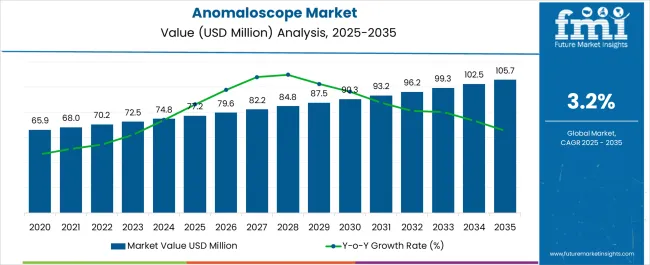
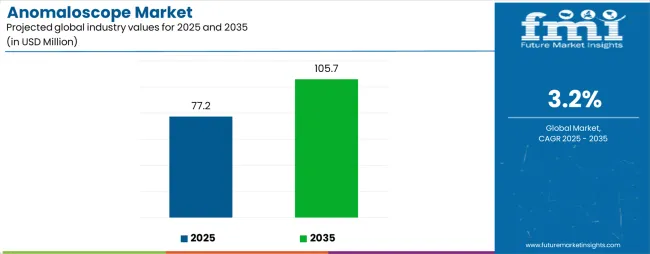
| Metric | Value |
|---|---|
| Anomaloscope Market Estimated Value in (2025 E) | USD 77.2 million |
| Anomaloscope Market Forecast Value in (2035 F) | USD 105.7 million |
| Forecast CAGR (2025 to 2035) | 3.2% |
The Anomaloscope market is experiencing steady growth, driven by increasing demand for precise color vision testing and advanced ophthalmic diagnostic solutions in clinical settings. Rising awareness about color vision deficiencies and their impact on professional eligibility, safety, and quality of life is contributing to the adoption of anomaloscopes in hospitals and diagnostic centers. Technological advancements, including digital integration, automated calibration, and enhanced spectral accuracy, have improved the precision and reliability of these devices, enhancing their clinical utility.
Growing investments in ophthalmic equipment by hospitals, eye clinics, and research institutions are further supporting market expansion. The adoption of anomaloscopes is being reinforced by regulatory guidelines and occupational requirements for professions such as aviation, transportation, and healthcare.
In addition, the increasing prevalence of ocular disorders and genetic color vision deficiencies is encouraging routine screening programs, which are boosting demand for high-performance diagnostic tools As hospitals and diagnostic facilities continue to prioritize accurate vision assessment, the anomaloscope market is expected to experience sustained growth, driven by innovation, clinical adoption, and integration with broader ophthalmic testing protocols.
The anomaloscope market is segmented by end-user, and geographic regions. By end-user, anomaloscope market is divided into Hospitals, Clinics, and Specialty Clinics. Regionally, the anomaloscope industry is classified into North America, Latin America, Western Europe, Eastern Europe, Balkan & Baltic Countries, Russia & Belarus, Central Asia, East Asia, South Asia & Pacific, and the Middle East & Africa.
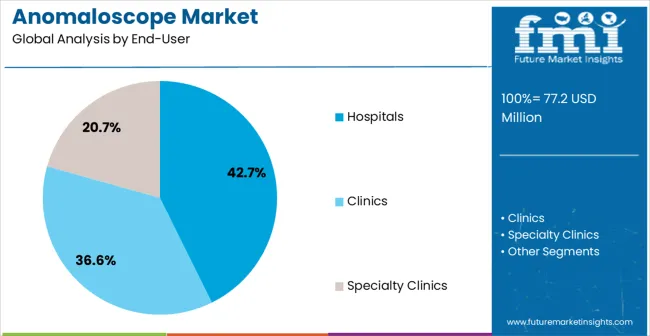
The hospitals end-user segment is projected to hold 42.7% of the anomaloscope market revenue in 2025, establishing it as the leading end-user category. Growth in this segment is being driven by the critical need for precise, reliable, and standardized color vision testing in clinical environments. Hospitals are increasingly investing in anomaloscopes to provide comprehensive ophthalmic diagnostics, enhance patient care, and support early detection of color vision deficiencies.
These devices enable objective and quantitative assessment of color perception, improving diagnostic accuracy and reducing reliance on subjective testing methods. Integration of anomaloscopes with electronic health record systems and other ophthalmic diagnostic tools facilitates streamlined workflows and enhances operational efficiency.
Additionally, the use of anomaloscopes in pre-employment screening, occupational health programs, and genetic counseling is reinforcing adoption in hospital settings As awareness of color vision deficiencies rises and hospitals continue to modernize their ophthalmic testing capabilities, this segment is expected to maintain its leading position, supported by technological advancements, clinical reliability, and demand for standardized vision assessment across patient populations.
Anomaloscope is a medical instrument used to test conditions of color blindness and for distinguishing between dichromats and anomalous trichromats. Anomaloscope is based on the Rayleigh match technology which is a mixture of both red and green light that has to match the red light source.
By matching this range, the different type of red-green color deficiency or color blindness can be identified. In addition, another anomaloscope is based on moreland match (blue-green) technology for the diagnosis of tritan defects.
The first anomaloscope was nagel anomaloscope, and with increasing technological advancement, new devices are introduced such as neitz anomaloscope, HMC (Heidelberg Multi Color) anomaloscope, or pickford-nicolson anomaloscope. Anomaloscope was discovered in 1907, and are widely accepted by ophthalmologist around the world. It is also used to measure both qualitative and quantitative abnormalities in color perception.
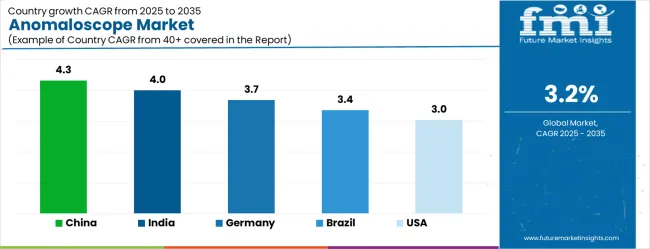
| Country | CAGR |
|---|---|
| China | 4.3% |
| India | 4.0% |
| Germany | 3.7% |
| Brazil | 3.4% |
| USA | 3.0% |
| UK | 2.7% |
| Japan | 2.4% |
The Anomaloscope Market is expected to register a CAGR of 3.2% during the forecast period, exhibiting varied country level momentum. China leads with the highest CAGR of 4.3%, followed by India at 4.0%. Developed markets such as Germany, France, and the UK continue to expand steadily, while the USA is likely to grow at consistent rates. Japan posts the lowest CAGR at 2.4%, yet still underscores a broadly positive trajectory for the global Anomaloscope Market. In 2024, Germany held a dominant revenue in the Western Europe market and is expected to grow with a CAGR of 3.7%. The USA Anomaloscope Market is estimated to be valued at USD 26.5 million in 2025 and is anticipated to reach a valuation of USD 26.5 million by 2035. Sales are projected to rise at a CAGR of 0.0% over the forecast period between 2025 and 2035. While Japan and South Korea markets are estimated to be valued at USD 4.2 million and USD 2.7 million respectively in 2025.
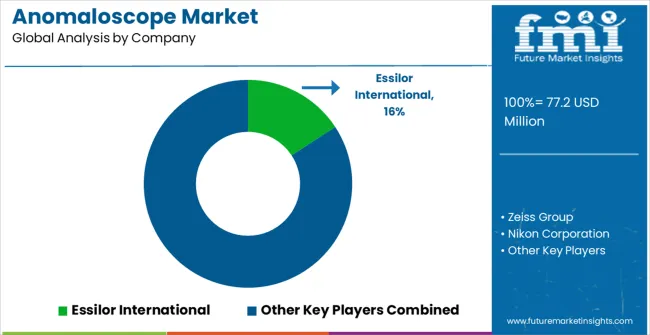
| Item | Value |
|---|---|
| Quantitative Units | USD 77.2 Million |
| End-User | Hospitals, Clinics, and Specialty Clinics |
| Regions Covered | North America, Europe, Asia-Pacific, Latin America, Middle East & Africa |
| Country Covered | United States, Canada, Germany, France, United Kingdom, China, Japan, India, Brazil, South Africa |
| Key Companies Profiled | Essilor International, Zeiss Group, Nikon Corporation, Hoya Corporation, Johnson & Johnson Vision Care, Alcon Inc., Bausch + Lomb, CooperVision, Topcon Corporation, and Carl Zeiss Meditec AG |
The global anomaloscope market is estimated to be valued at USD 77.2 million in 2025.
The market size for the anomaloscope market is projected to reach USD 105.7 million by 2035.
The anomaloscope market is expected to grow at a 3.2% CAGR between 2025 and 2035.
The key product types in anomaloscope market are hospitals, clinics and specialty clinics.
In terms of , segment to command 0.0% share in the anomaloscope market in 2025.

Thank you!
You will receive an email from our Business Development Manager. Please be sure to check your SPAM/JUNK folder too.
Chat With
MaRIA